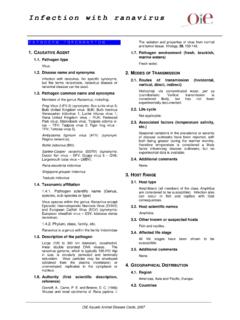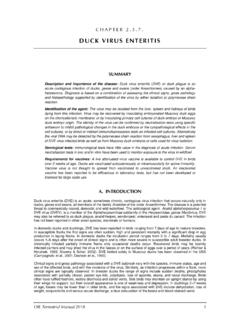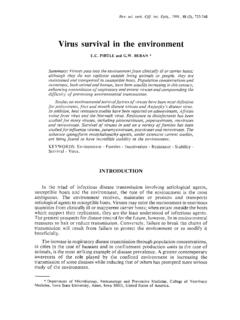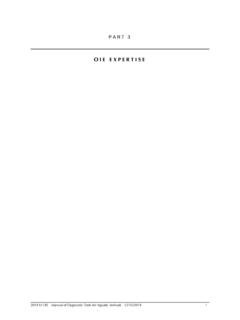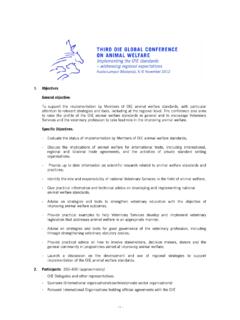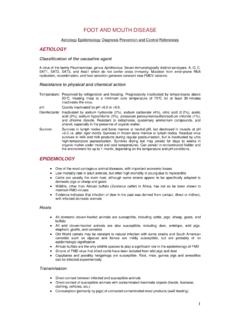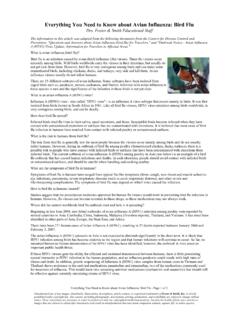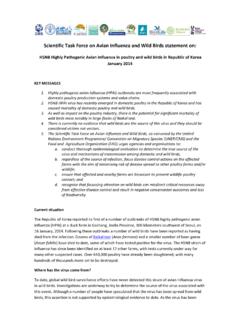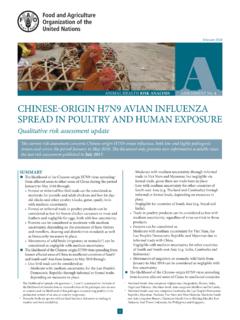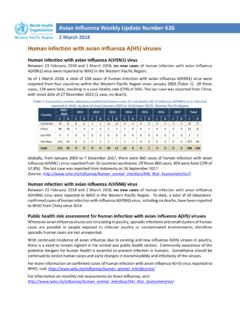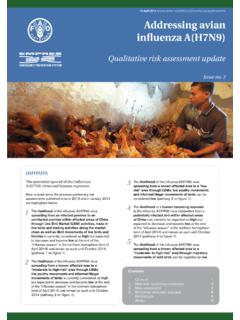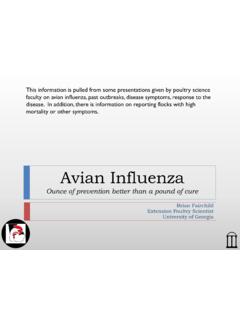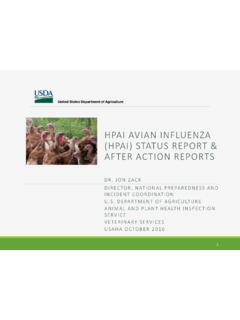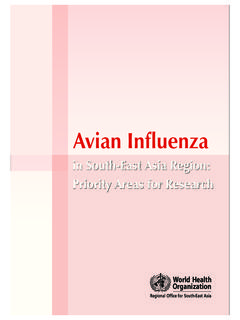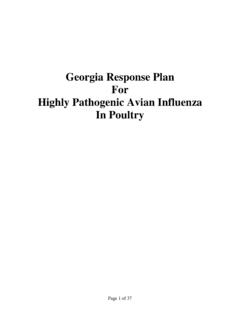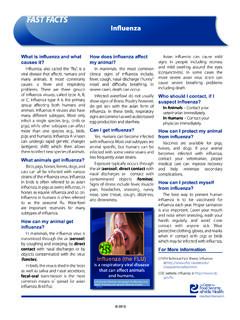Transcription of Avian influenza in Mexico - Home: OIE
1 Rev. sci. tech. Off. int. Epiz., 2009,28(1), 261-265 Avian influenza in MexicoC. VillarrealMexico United States Commission for the Prevention of Foot and Mouth Disease and other Exotic AnimalDiseases; Animal Health Directorate, Mexican National Services for Food Safety and Quality and AnimalHealth, Ministry of Agriculture, Livestock, Rural Development, Fisheries and Food, MexicoE-mail: and outbreak of highly pathogenic Avian influenza (HPAI) H5N2 in Mexico in 1994led to a clear increase in biosecurity measures and improvement of intensivepoultry production systems. The control and eradication measures implementedwere based on active surveillance, disease detection, depopulation of infectedfarms and prevention of possible contacts (identified by epidemiologicalinvestigations), improvement of biosecurity measures, and restriction of themovement of live birds, poultry products, by-products and infected material.
2 Inaddition, Mexico introduced a massive vaccination programme, which resultedin the eradication of HPAI in a relatively short time in two affected areas that hada high density of commercial influenza Control Emulsified vaccine Eradication Experience H5N2 Highly pathogenic Avian influenza Mexico Recombinant is the fourth largest producer of chicken meat inthe world and the seventh largest egg producer. Thepoultry industry is the most developed of all the livestockindustries in Mexico . In 2006, the production of poultrymeat and eggs was million and million tons,respectively, which represents 35% of the country sLivestock Gross National Product.
3 The country has 3,800 commercial poultry farms. The Jalisco andGuanajuato States and the Lagunera Region are the mainpoultry meat producers. Jalisco, Puebla and Sonora Statesare the main egg producers, but the other states alsoproduce eggs. The annual per capita consumption is kg of eggs and kg of chicken meat (2).Detection of Avian influenza in MexicoIn Mexico , low pathogenicity Avian influenza (LPAI) H5N2 virus was detected for the first time in March , the situation throughout the country wasassessed by detecting serological evidence of the presenceof H5N2 virus.
4 As a result, positive flocks without apparentclinical signs were found in commercial poultry andbackyard bird populations in half of the country. A repopulation programme began, which included a standstill period (empty barns) and cleaning anddisinfection of facilities. In December 1994, clinical signsof highly pathogenic disease began appearing. The virushad mutated, affecting 2 million layers in Puebla State, a densely populated zone with 25 million layer chickens on140 farms. Later, in January 1995, a similar virus appearedon broiler and breeder farms in Queretaro State, affecting 20 million chickens and 400,000 breeders.
5 Eradication of highly pathogenic Avian influenza The eradication activities introduced in these two statesincluded control of the interstate movement of poultry andpoultry products, depopulation of affected farms, standstillperiods, cleaning and disinfection of facilities,improvement of biosecurity measures on farms, use ofsentinel birds before repopulation, and vaccination of allbirds. In addition, vaccination of long-cycle layer farmswas performed in states where cases of LPAI virus (LPAIV)were detected. Between January and December 1995, 383 million doses of vaccine were administered.
6 Highly pathogenic Avian influenza (HPAI) was last isolatedin May 1995, five months after the initiation of theemergency operation. In December 1995, the Governmentdeclared Mexico HPAI-free. The estimated cost of the emergency programme was US$49 million, coveringthe operation, biosecurity, vaccination and the value of dead and destroyed birds (1). As there were no funds forcompensation, the value of the culled poultry was coveredby the affected enterprises. Highly pathogenic avianinfluenza in Mexico only affected poultry; no cases inhumans or other species were identified.
7 So far, the onlysubtype detected in poultry in Mexico has been June 1995 all the isolated viruses have beenidentified as LPAI surveillance and controlOnce HPAI had been eradicated, a control and eradicationcampaign for LPAIV began. The campaign included thefollowing components: establishment of free farms replacement of positive flocks with negative flocks control of the movement of live birds and products sampling and laboratory diagnosis every three monthsat farms confirmed to be free of Avian influenza (twice ayear in sentinel birds at farms where vaccine had beenused) vaccination of flocks in which LPAIV is detected inorder to prevent mutation to campaign against LPAI is still in force.
8 RegulationNOM-044-ZOO-1995 (National Campaign against AvianInfluenza) continues to be implemented with the aim ofmonitoring and eradicating LPAIV, which is still present insome regions of the country and is affecting backyard birdsas well as commercial flocks. These measures have beentaken in order to prevent mutation of LPAIV to also has a national campaign for surveillance andprevention of HPAI, which is operated jointly by thegovernment and the poultry industry. Facing the threat of HPAIV H5N1 that is affecting Asia,Africa and several European countries, the Mexicanveterinary and public health services regularly jointlyupdate national plans for preparedness and response incase of a human influenza pandemic, and for thesurveillance and prevention of Avian influenza .
9 Anychanges are made in accordance with the recommendedguidelines for influenza prevention of internationalorganizations such as the World Health Organization, theFood and Agriculture Organization of the United Nationsand the World Organisation for Animal , diagnosis is performed at four official referencelaboratories and 19 authorised private laboratories. Thelaboratory tests used are mainly haemagglutinationinhibition specific for H5, agar gel precipitation, virusisolation and subtyping, and nucleotide sequencing. Vaccination is carried out (under the direct control ofofficial veterinary emergency services) in all areas whereLPAI exists in order to prevent the emergence of HPAIV strains.
10 The vaccine that has been used since vaccinationbegan in 1995 is the inactivated, emulsified LPAIVA/CK/M xico/CPA/232/94 (H5N2) vaccine, which hasbeen highly efficient in preventing and eradicating laboratory trials and field experiments, vaccinatedpoultry challenged with field virus did not show signs ofillness, but could infect other birds for several days,indicating that the vaccine did not prevent infection orvirus excretion, even though it was effective in preventingclinical manifestations of disease. Since 1998, use of a recombinant poxvirus-H5 vaccine hasalso been authorised in Mexico for use in broilers.

